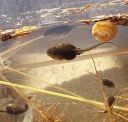Eastern Spadefoot (Scaphiopus holbrookii)
Description: The average length of an adult eastern spadefoot is 1+3/4–2+1/4 inches. It is brownish in color, with two yellowish stripes on its back. These stripes, which begin on the upper eyelids, may diverge or converge, resulting in a pattern resembling a lyre or an hourglass. Some specimens may be very dark, with less distinct markings. It has one spur on each of its back feet for burrowing. A similar species is Hurter's spadefoot toad, which was once considered a subspecies of S. holbrookii.
Habitat: Scaphiopus holbrookii spends almost all of its life deep underground; coming out only to breed, and sometimes eat. It remains in a type of hibernation almost all its life. It burrows in a spiral, preferring sandy soils.
Research has looked into the habitat selection of the species, and has found that it tends to hover around upland areas. It has shown preference for being close to deciduous shrub edges, low-growing pitch pine branches, and reindeer lichen. This environment provides an easy place to burrow land, with dense prey biomass, and protection from predators.
Range: It is found in the southeastern United States, except for mountainous areas, and is also found northward along the Atlantic coast, through the Mid-Atlantic states, into southern New England, including eastern Massachusetts. It is found in inland states such as Pennsylvania and New York, but only as far westward as the Appalachian Mountains, and the Hudson River Valley in New York.
Diet: Although Scaphiopus holbrookii is both diurnal and nocturnal, most foraging for food sources consisting of small invertebrates such as termites, insects, arachnids, worms, is completed during the day. Some species will completely leave to burrow in search of prey, however, a common tactic for the eastern spadefoot is to simply sit at the opening of the burrow and waiting for prey to pass by.
Reproduction: S. holbrookii requires fish-free ephemeral ponds for breeding but occupies other habitats such as longleaf pine and wiregrass ecosystems when not breeding. Eastern spadefoot toads are explosive breeders during sufficient rainfall and eggs are usually attached to submerged vegetation. Due to the explosive breeding once eggs hatch often food becomes limited from the large populations of tadpoles. S. holbrookii tadpoles are known to be omnivorous. In the event of food shortages some larva adapt aggressive feeding habits consuming large animal prey including other S. holbrookii tadpoles. These cannibalistic morphs develop a heightened rate and become much larger tadpoles in comparison to the non-cannibal morphs.
Status: vWhile not listed as an endangered species by the U.S. federal government, S. holbrookii is considered "threatened" in Massachusetts. In that state and in 13 others, it is listed as a "Species of Greatest Conservation Need".
»» Kingdom: Animalia - Animals
»» Phylum: Chordata - Chordates
»» Subphylum: Vertebrata - Vertebrates
»» Class: Amphibia - Amphibians
»» Order: Anura - Frogs & Toads
»» Family: Scaphiopodidae - American Spadefoot Toads
»» Genus: Scaphiopus
»» Species: Scaphiopus holbrookii - Eastern Spadefoot
»» Subspecies: None
This article uses material from the Wikipedia article "Scaphiopus olbrookii", which is released under the Creative Commons Attribution-Share-Alike License 3.0. Content may have been omitted from the original, but no content has been changed or extended.
|







